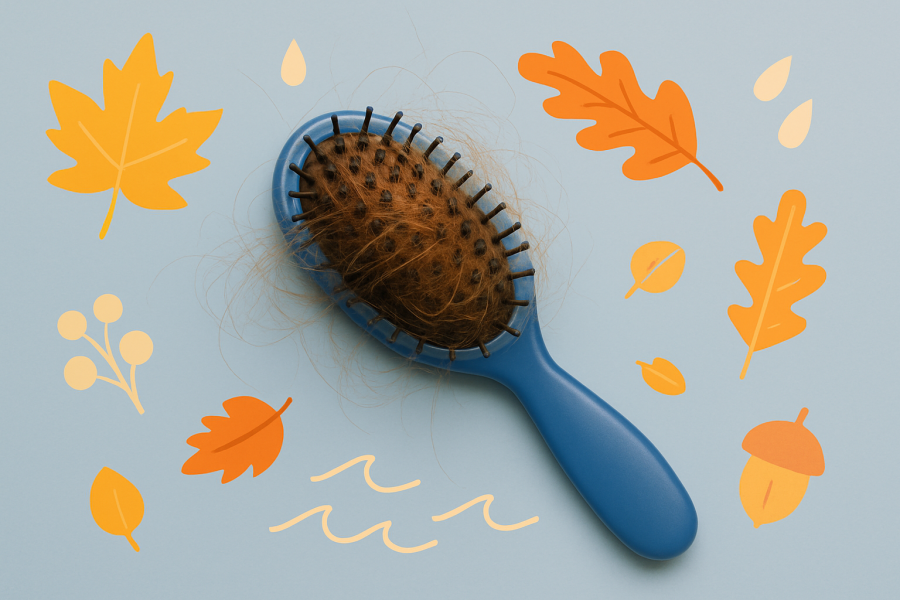Sharing our best cold-season hair protection tips

How to Get Your Hair Ready for Hats and Cold Weather
Autumn brings more than cozy scarves and hot drinks — it also brings a real challenge for your hair.
Cold wind, dry air from heating, and synthetic fabrics can all strip away your hair’s natural protective layer and irritate the scalp.
The result? Breakage, dryness, static, and even seasonal shedding.
But the good news — you can prevent it all with a few smart adjustments before the cold truly sets in.
1. Rebuild your hair’s protective barrier
Each strand of hair is made up of three layers:
- Cuticle — the outer shell of overlapping cells that protect the inner structure;
- Cortex — the strong, elastic layer that gives hair its strength and flexibility;
- Medulla — the core channel running through the center.
When the cuticle gets damaged by cold, friction, or hot air, moisture escapes — hair turns dull, rough, and fragile.
💡 Goal: Strengthen the cuticle and restore the lipid layer.
🔹 Choose shampoos with mild surfactants, such as:
Sodium cocoyl isethionate, Cocamidopropyl betaine, Disodium cocoamphodiacetate.
They cleanse gently without drying out the scalp.
🔹 Always follow with a conditioner or mask. Look for:
- Ceramides, phytosphingosine, phospholipids — to restore the lipid barrier;
- Hydrolyzed keratin, amino acids, peptides — to strengthen the hair shaft;
- Oils (argan, jojoba, macadamia, shea) — to soften, smooth, and prevent dehydration.
🔹 Dry your hair with warm or cool air — not hot. (Air-drying completely isn’t ideal either in cold weather.)
🔹 Seal the ends with a serum containing lightweight silicones or esters to protect from friction and cold.
And yes — silicones aren’t bad, as long as you use a clarifying shampoo once a month to wash away buildup.
2. Keep your scalp healthy
Under a hat, your scalp “overheats”: trapped warmth, sweat, and excess sebum create a perfect environment for imbalance.
That can lead to irritation, dandruff, or itching — especially if you don’t cleanse properly.
💡 Goal: Cleanse the scalp gently but regularly.
🔹 Once a week, use a scalp exfoliant — either an acid-based formula (with lactic, gluconic, or salicylic acid) or a mild salt scrub.
For sensitive scalps, choose acids in concentrations up to 3% with a pH above 4.5 — gentle enough to exfoliate without irritation.
🔹 If you struggle with oiliness or itching, try a scalp tonic or serum containing zinc, piroctone olamine, panthenol, or niacinamide.
🔹 Avoid applying thick oils or heavy masks directly to the scalp — they can clog follicles and trigger inflammation.
3. Balance protein and moisture
Healthy hair needs both — structure and hydration.
Too much protein makes it stiff and brittle, while too much moisture leaves it limp and “cottony.”
💡 Goal: Find the sweet spot.
🔹 Once a week — use a protein mask (with keratin, silk proteins, or collagen).
🔹 Once a week — use a moisturizing mask (with hyaluronic acid, aloe, or betaine).
🔹 Always finish with a leave-in cream or conditioner after every wash to keep the balance sealed in.
4. Hats aren’t your enemy
There’s a myth that wearing a hat damages your hair — but the opposite is true.
At temperatures below +5 °C, blood vessels in the scalp constrict, and follicles receive less nourishment.
That can cause temporary hair weakening and shedding.
So yes — your mom was right about the hat.
💡 How to choose a good one:
- Natural fabrics (cotton, wool, or cashmere blends);
- A soft inner lining that doesn’t snag or cause friction;
- Not too tight — it shouldn’t constrict blood flow;
- Wash regularly — sweat and sebum buildup on fabric can irritate the scalp.
5. Support your hair from the inside
Even the best shampoo can’t fix a nutrient deficiency.
In autumn and winter, it’s common to see lower levels of vitamin D, ferritin (iron), zinc, and vitamin B12 — all crucial for the hair growth cycle.
💡 Tip:
Get a blood test before taking any supplements.
Avoid taking biotin, iron, or vitamin D blindly — excess can be just as harmful as deficiency.
6. Manage stress and get your sleep
Chronic stress raises cortisol levels, which can push follicles into a “resting” phase — and a few months later, you notice increased shedding.
So yes, a full night’s sleep, fresh air, and a hot bath can sometimes do more for your hair than another mask.
Bottom line
Cold weather isn’t your hair’s enemy — lack of preparation is.
Take care of your scalp, nourish and protect the strands, wear that hat proudly, and your hair will stay healthy, glossy, and strong all season long.



Leave a Comment